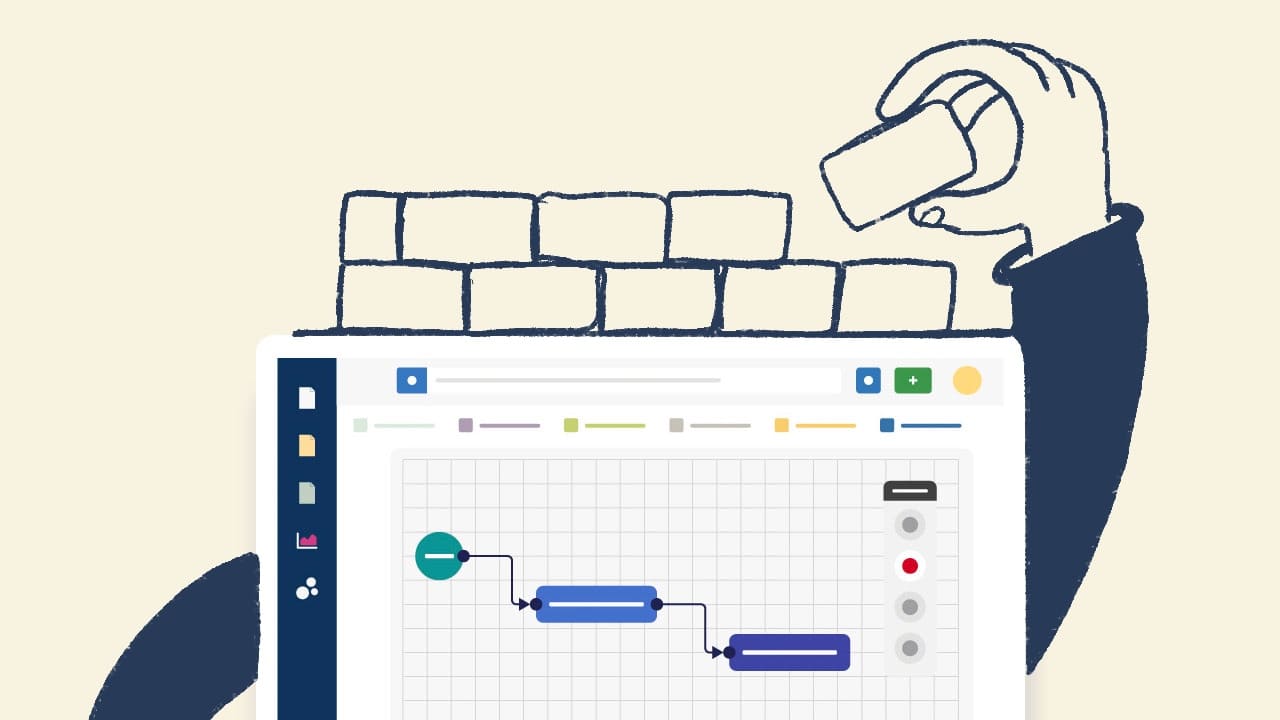Company leaders and key stakeholders often face the challenge of aligning short- and long-term business goals with specific technologies while minimizing costs and risks. One effective solution is developing a comprehensive IT strategy.
IT strategies and roadmaps provide a structured plan: a synthesis of strategy and coordination across an organization. They outline how technology investments will support the overall business strategy, guide engineering and IT teams, and reassure executives about their investments' returns.
In this article, we take an in-depth look at crafting a successful IT strategy, from understanding its importance to integrating advanced technologies and overcoming common challenges.
Understanding IT strategy
An IT strategy is a comprehensive, long-term plan that outlines how an organization will utilize technology to achieve its goals and objectives. At its core, it aligns technology with an organization's business strategy, ensuring that technology investments align with business priorities and deliver maximum value.
A well-defined IT strategy is essential for businesses aiming to remain competitive and achieve their desired outcomes. It is a guiding document that directs the organization’s information technology strategy and related decisions and investments.
With a clear IT strategy, companies can better manage their resources, anticipate future needs, and respond more agilely to market changes.

Examples of IT strategies
An IT strategy acts as a roadmap, illustrating how technology can propel an organization towards its business objectives. Aligning IT initiatives with business goals is critical in staying ahead of competitors, improving customer experiences, and enhancing operational efficiency.
To achieve this, organizations must understand their business objectives clearly and assess how technology can support these goals. This involves identifying key business drivers and determining how IT can enable and enhance business success in these areas.
For example, suppose a business aims to improve customer service. In that case, the IT strategy might focus on implementing advanced customer relationship management (CRM) systems or leveraging data analytics to further customer satisfaction and gain insights into customer behavior.
Another possible objective is the quest to reduce operational costs. In this case, the automation of certain tasks and the implementation of workflow automation through specific IT tools would be the way forward.
IT strategy design principles
Target architecture
The target architecture is the desired future state of the organization’s technology landscape. This design should be consistent and clearly defined across various IT domains. It is a detailed blueprint for achieving business objectives, including the necessary architecture, systems, and processes.
In practice, this means identifying what the IT environment should look like in the future, specifying the technologies and processes that will be in place, and ensuring these elements align with the organization's goals. A well-crafted target architecture helps to visualize the end goal and provides a clear path to follow.
However, given the dynamic nature of technology and innovation, it's crucial to maintain flexibility within the target architecture. While it is important to have a clear aim, the final objectives should be adaptable to accommodate new developments and changing business needs. This balance ensures that the IT strategy remains relevant and effective over time, allowing the organization to "hit the target" while staying agile and responsive to technological advancements.
IT Governance and creating an environment of collaboration and innovation
Establishing IT governance, while optional, is highly recommended. Effective IT governance ensures the IT strategy is implemented and managed consistently across the organization. It involves clearly defining roles and responsibilities, establishing decision-making processes, and implementing mechanisms for monitoring and controlling IT initiatives.
A governance framework includes policies and procedures to guide IT activities. This framework helps ensure that IT decisions are made following the overall business strategy and that accountability exists at all levels.
IT governance also includes regular reviews and audits to track progress and make adjustments as necessary. A strong IT governance is the best way for organizations to manage risks better, ensure compliance, and achieve their strategic goals more effectively.
But it also plays a central role in promoting an organizational culture receptive to technological innovation, for which it is essential to involve stakeholders and encourage their participation. In this way, the resistance that could be generated by the incorporation of new IT tools in the company is mitigated.
Risk Management and Compliance
Any change in IT implemented within the organization involves Risk Management and compliance to avoid security issues and legal penalties.
Risk Management is a structured practice that allows the identification of underlying threats in a technological innovation and the development of plans to mitigate them, while also having complementary plans to address potential failures or issues during the implementation process.
Meanwhile, Compliance Management is another fundamental practice that ensures any change initiative in the IT infrastructure adheres to the company's and business's regulations.

Guaranteed resources for implementing the plan
The technological innovation strategies include the use of additional resources both for acquiring new tools or adjusting existing ones, and for training professionals and involved parties in their use.
This requires approval of these investments by the company's management levels. Therefore, a clear justification of how the technology will drive the achievement of general business objectives is necessary.
This is an ongoing process in which one must stay informed about trends and the evolution of computing elements to remain competitive.
Continuous improvement, flexibility, and scalability are other key points for ensuring that a company's technology strategy remains sustainable over time. To achieve this, it is necessary to measure and evaluate the process using pre-selected KPIs.
Key steps to developing a solid IT strategy
Developing an effective IT strategy involves several key steps and considerations:
-
Understanding business goals: The first step is deeply understanding the organization’s business goals and objectives.
-
Assessing current technology infrastructure: Evaluate the organization's current technology. This assessment includes identifying existing systems, processes, and capabilities and understanding any gaps or areas for improvement.
-
Identifying opportunities for technology leverage: Based on the previous steps, identify areas where technology can be leveraged to achieve the organization’s objectives. This might involve adopting new technologies, optimizing existing systems, or implementing process improvements.
-
Defining IT principles: Establish IT principles to guide the strategy development process. The principles will act as filters to ensure the target state design aligns with the organization’s goals.
-
Designing the target architecture: Develop a consistent, clearly defined target across various IT domains. It should describe the desired future state of the organization’s technology environment, including key systems, processes, and capabilities.
Implementation and execution: IT roadmap and Change Management
The development of an IT strategy concludes with the creation of a written document and an IT roadmap. This roadmap serves as a detailed plan for implementing the IT strategy, outlining key initiatives, associated costs, milestones, and roles and responsibilities.
The IT roadmap should include:
-
Key initiatives: Outline the major projects and initiatives that will be undertaken to achieve the target state.
-
Associated costs: Provide a detailed budget for each initiative, including capital and operational expenditures.
-
Milestones: Define key milestones and deliverables for each initiative, ensuring that progress can be tracked and measured.
-
Roles and responsibilities: Clearly define the roles and responsibilities of individuals and teams involved in implementing the IT strategy.
Implementing an IT strategy requires strong IT leadership and collaboration with various departments, including business, budget, and legal. Effective Change Management is critical to ensure that the entire organization can adapt to the new technology and realize the benefits of the IT strategy.

Change Management involves:
-
Communication: Clearly communicate the IT strategy and its benefits to all stakeholders, ensuring everyone understands the goals and objectives.
-
Training and support: Provide training and support to employees to help them adapt to new systems and processes.
-
Monitoring and evaluation: Continuously monitor and evaluate the implementation process, making necessary adjustments to ensure successful execution.

The role of the IT department
The IT department plays a pivotal role in developing and implementing an effective IT strategy. IT leaders must work closely with their business counterparts to shape this strategy, considering research and reports to understand trends impacting the organization’s market. Collaboration will be the key because the IT strategy shouldn't be developed in isolation; it should be tightly integrated with the overall business strategy.
A thorough review of the IT team is also necessary to ensure there are sufficient personnel with the right expertise to support new initiatives and ongoing operations. It's important to evaluate the current staff's skills and capabilities, identify opportunities, and plan for training or recruitment as needed.
Leveraging emerging technologies
Emerging technologies like artificial intelligence (AI), blockchain, and the Internet of Things (IoT) are rapidly transforming the business landscape. Integrating these technologies into the IT strategy involves identifying how they can enhance the organization’s processes, systems, and services.
A proactive approach is the best way to explore new technologies, understand their potential impact, and strategically incorporate them into the IT roadmap. Agility and flexibility are critical components of an IT strategy that embraces emerging technologies.
Organizations need to be able to quickly adapt to new technological developments and integrate them seamlessly into their operations. This means building a culture that is open to change, investing in scalable and flexible IT systems and infrastructure, and continuously monitoring technological trends to stay ahead of the curve.

Common challenges
As mentioned, a robust IT strategy can help organizations ensure that technology investments drive business success and competitive advantage. However, when evaluating or implementing a new IT strategy, organizations often encounter challenges that can block the introduction of changes and deter progress.
Here are some common issues and key factors to consider to address them:
-
Resistance to change: Employees and even management can be resistant to new processes and technologies. Overcoming this requires clear communication about the benefits of the new IT strategy and involving stakeholders early in the planning process to gain their support.
-
Resource constraints: Limited budgets, time, and personnel can pose significant barriers. Prioritizing initiatives based on business impact, securing executive buy-in for necessary resources, and exploring cost-effective solutions are critical steps to address these constraints.
-
Technology integration: Integrating new technologies with existing systems can be complex and risky. Conducting thorough assessments of current infrastructure, planning for phased implementations, and allocating sufficient resources for integration efforts can help mitigate these risks.
-
Data security and compliance: New IT initiatives can introduce security vulnerabilities and compliance issues. To protect the organization’s data and ensure compliance, robust security measures must be implemented, regulatory requirements must be updated, and regular audits must be conducted.
-
Measuring success: Establishing clear metrics and KPIs to measure the success of the IT strategy can be difficult. Defining relevant performance indicators, setting realistic targets, and regularly reviewing progress is crucial to evaluating and refining the strategy. We'll cover this in the next section.
Human Centered Leadership
Discover the power of embracing the human element in IT and leadership
Download for free
Measuring IT strategy success
Evaluation and monitoring are essential components of any IT strategy. Several metrics can be used to assess the effectiveness of an IT strategy and help organizations track progress and make data-driven decisions.
Key metrics may include:
-
Agility: How quickly the IT department can respond to changes and implement new technologies.
-
Project delivery time: The efficiency of delivering IT projects on time and within budget.
-
Customer and employee satisfaction: The impact of IT initiatives on customer experience and employee productivity.
-
Marketing and sales ROI: The return on investment from technology that supports marketing and sales efforts.
-
Capacity utilization: The efficiency of IT resource usage.
-
Service-level indicators: Metrics related to system uptime, response times, and overall service quality.
Conclusion
In conclusion, a robust IT strategy can help align IT initiatives with business objectives, leveraging emerging technologies and overcoming common challenges.
The role of the IT department, coupled with strong governance and continuous evaluation, ensures that the IT strategy evolves in tandem with market trends and business needs. Embracing these principles enables organizations to have innovative solutions to achieve their current goals and adapt and thrive in the face of future technological advancements.
With a well-crafted IT strategy, businesses are better positioned to enhance performance, minimize errors, delight customers, and drive sustainable business growth.















